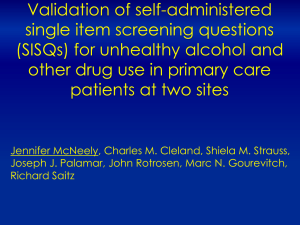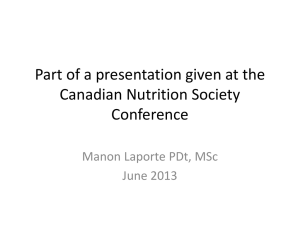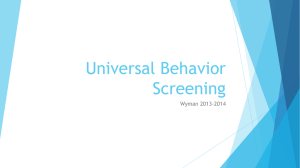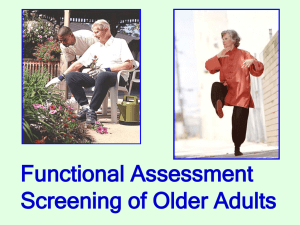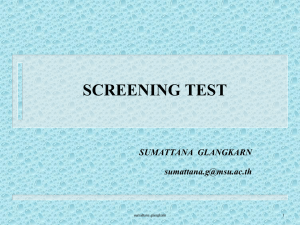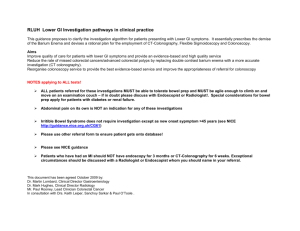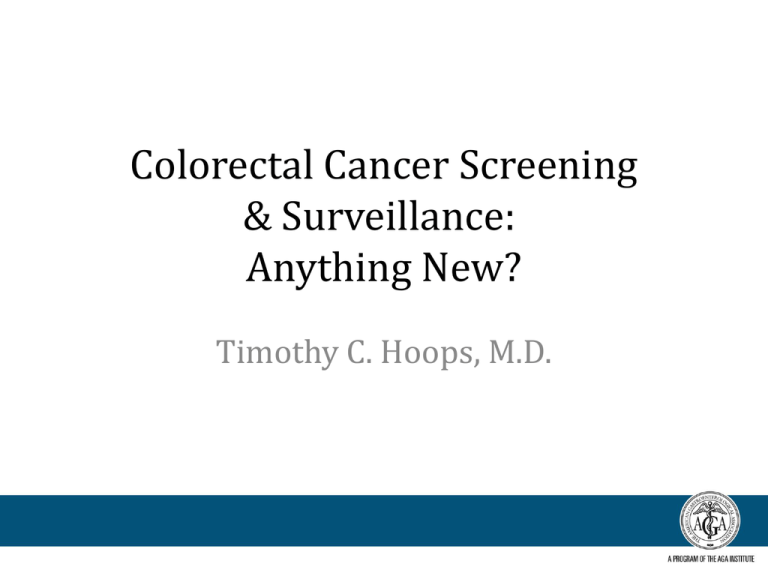
Colorectal Cancer Screening
& Surveillance:
Anything New?
Timothy C. Hoops, M.D.
Case
• A 53-year-old male presents to the office with a history of
greater than 15 years of esophageal reflux symptoms
including heartburn, regurgitation and episodes of
hoarseness. He has been treated with omeprazole 20 mg
once daily but has breakthrough symptoms at times for
which he takes a 2nd dose. He denies dysphagia.
He has no family history of colon cancer
• His physical exam is unremarkable.
• What might you recommend?
Screening for Colon Cancer
• ACS estimates that in the US in 2014:
– 136,830 new CRC diagnoses
– 50,310 CRC deaths
– Lifetime risk for CRC:
• Men
5%
• Women 4.7%
• 3rd leading cause of death in both men and
women
Screening for Colon Cancer
• Ideal screening study
– Prevalent disease
– Effective
– High sensitivity and specificity
– Safe
– Available
– Convenient
– Cheap
Incidence/Mortality - Heritage/Race
Siegel, CA Cancer J Clin 2014;64:104
Screening Guidelines
• USPSTF – 2008
– Screening for CRC beginning age 50 to age 75
•
•
•
•
FOBT
Sigmoidoscopy
Colonoscopy
Insufficient evidence for stool DNA & CT
colonography
– Recommend screening in 75-85 y/o based on
individual considerations
– Recommend against screening > age 85
Ann Intern Med. 2008; 149: 627
Screening Guidelines
• ACS, US Multisociety Task force and
American College of Radiology – 2008
– Tests that detect adenomatous polyps and
cancer (detect and prevent cancer)
•
•
•
•
Flexible Sigmoidoscopy every 5 years, or
Colonoscopy every 10 years, or
Double Contrast Barium Enema every 5 years, or
CT Colonography every 5 years
Gastroenterology 2008; 134:1570
Screening Guidelines
• ACS, US Multisociety Task force and
American College of Radiology – 2008
– Tests that primarily detect cancer
• Annual gFOBT with high test sensitivity for cancer, or
• Annual FIT with high test sensitivity for cancer, or
• sDNA, with high sensitivity for cancer, interval
uncertain
Gastroenterology 2008; 134:1570
Screening Guidelines
American College of Gastroenterology
• Cancer Prevention tests offered first
– Beginning age 50; age 45 in AA
– Colonoscopy every 10 years
– Alternatives:
• Sigmoidoscopy
• CT colonography
– Family Hx CRC
• > age 60 – as per average risk
• < age 60 – start age 40 and Q 5 years
Rex; Am J Gastroenterol 2009; 104:739
Screening Guidelines
• Cancer Detection tests for those declining
prevention tests
– Fecal immunochemical test – annual
– Alternatives
• Hemoccult Sensa
• Fecal DNA
Rex; Am J Gastroenterol 2009; 104:739
Screening
• In 1980’s and 1990’s, most screening was
FOBT and sigmoidoscopy
• Since about 2000, most CRC screening in the
US has been with colonoscopy
• No published randomized controlled trial of
colonoscopy to date
Has it been effective?
CRC Trends
Siegel, CA Cancer J Clin 2014;64:104
Polypectomy – CRC Mortality
Zauber AG et al. N Engl J Med 2012;366:687-696.
Colon Cancer and Screening Rates
Yang, DX. Cancer 2014; 10:1002
Colon Cancer and Screening Rates
Estimated number of
cancers prevented over 3
decades:
236,000 to 550,000
Yang, DX. Cancer 2014; 10:1002
So what is wrong with
colonoscopy as a
screening study?
Screening for Colon Cancer
• Ideal screening study
– Prevalent disease
– Effective
– High sensitivity and specificity
– Safe
– Available
– Convenient
– Cheap - $$$
Screening Rates
Colorectal Cancer Screening Among Adults Aged 50 Years or Older, United States, 2010Z
CHARACTERISTIC
FOBTa
ENDOSCOPYb
Sex
Men
9.0
57.4
Women
8.6
55.6
Age, years
50-64
8.0
52.3
65+
9.7
61.2
Race/ethnicity
White (non-Hispanic)
9.2
58.5
Black (non-Hispanic)
8.4
53.0
Asiand
6.9
44.5
American Indian/Alaska
6.1
46.5
Nativee
Hispanic/Latino
5.6
45.3
Education, years
≤11
5.8
42.1
12
6.8
51.9
13 to 15
11.0
59.5
16+
10.4
66.7
EITHER FOBT or ENDOSCOPYc
60.2
58.3
55.2
63.7
61.5
55.5
45.9
48.1
47.0
43.9
54.2
63.1
69.2
Health insurance coverage
Yes
9.2
59.4
62.2
No
1.6
17.8
18.8
Effectiveness of Colonoscopy
• Reduction of cancers more in left colon than
in right
• Biological differences
• Quality issues
– Cecal intubation rates
– Adenoma detection rates
– Prep quality
• Split dose preps
CT Colonography
CT Colonography
CT colonography
Colonoscopy
66.8% (62.7–70.8%)
80.3% (77.7–82.8%)
92.5% (89.0–95.2%)
73.2% (67.7–78.1%)
Global
Sensitivity
Specificity
Subgroup analysis
Lesions between 5 and 7 mm
Sensitivity
77.1% (73.3–80.5%)
Specificity
87.4% (86.3–88.4%)
Lesions between 8 and 10 mm
Sensitivity
86.7% (81.7–90.7%)
Specificity
90.0% (89.1–91.0%)
Lesions > 10 mm
Sensitivity
91.2% (86.5–94.6%)
Specificity
87.3% (86.2–88.3%)
86.7% (81.3–91.0%)
98.0 (97.1–98.6%)
88.5% (81.5–93.6%)
99.2% (98.6–99.5%)
92.9% (86.0–97.1%)
91.3% (89.9–92.5%)
Martin-Lopez, Colorectal Disease 2013; 16:O82
CT Colonography
• Pooled sensitivity/specificity for advanced
neoplasia and cancer
CT colonography
Colonoscopy
Sensitivity
96.8% (89.0-99.6%)
91.2% (80.7-97.1%)
Specificity
99.0% (98.7-99.2%)
100% (99.9-100%)
Global
Martin-Lopez, Colorectal Disease 2013; 16:O82
CT Colonography
• Advantages:
–
–
–
–
Rapid
No sedation
Lower procedural risk
Extracolonic findings
• Disadvantages
–
–
–
–
–
Same prep as for colonoscopy (? prep-less procedures)
Discomfort with insufflation
Radiation
Contrast allergy
Need for a colonoscopy for positive findings
Fecal Immunochemical Testing
FIT
FIT
• Antibody to human globin
– Doesn’t cross react with dietary meats
– No need to avoid foods with peroxidase activity
– Measures colonic blood – upper GI globin is
digested
– Fewer samples needed than FOBT
– Increased sensitivity and specificity compared
to FOBT
Pooled sensitivity/specificity for FIT
68.45%
98.50%
Lee, Annals of Internal Medicine. 160(3):171-181, February 4, 2014.
FIT
•
•
•
•
Relatively cheap
Good sensitivity and specificity profile
Higher participation rates than colonoscopy
Not good for detecting polyps
Stool DNA Testing
Stool DNA Testing
• Multiple studies with numerous DNA
markers
• Target shed DNA from shed cells
• Look for DNA markers present in
malignancies
– Aberrantly methylated BMP3 and NDRG4
promoter regions
– Mutant KRAS
– actin
– FIT
Imperiale TF et al. N Engl J Med 2014;370:1287-1297.
Imperiale TF et al. N Engl J Med 2014;370:1287-1297.
Imperiale TF et al. N Engl J Med 2014;370:1287-1297.
Imperiale TF et al. N Engl J Med 2014;370:1287-1297.
Serum Testing
Methylated Sept9
• Sept9 encodes the protein Septin 9, part of a
protein complex active in mitotic cell division
• Colon cancer has increased levels of mSEPT9
• Initial studies showed increased serum levels
of mSept9 in patients with colon cancer
• Initial retrospective case-control studies
– Sensitivity
– Specificity
52% to 72%
90 to 95%
mSept9
• Prospective trial in screening population
• 7941 patients , 53 CRC cases, 3025 adenomas
Sensitivity
Specificity
• CRC (all)
48.2% (32.4-63.6%) 91.5% (89.7-99.5%)
– Stage I
– Stage II
– Stage III
– Stage IV
– Adv Aden
35.05%
63.05%
46.0%
77.4%
11.2%
Church, TR. Gut 2014; 63:317
Colon Cancer Screening
• So which test should be done?
The Best Test Is
The One That Gets
Done

